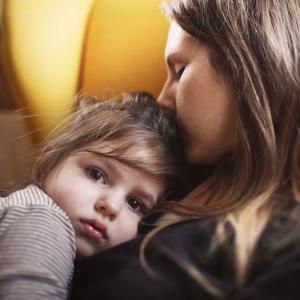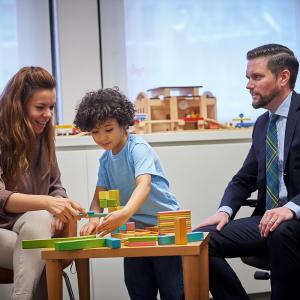
Photo: Elva Etienne/Getty
The parents of many comic book superheroes have short and tragic lives. Little orphan Annie never even found hers, and Batman and Gamora were forced to watch their parents die. Out of this tragedy and trauma, these individuals develop superhuman qualities—they fight injustice and have tremendous resilience.
Children are drawn to these stories, and in them, we are given a possible narrative for some of the things the future may hold. Many parents are currently wondering what the lasting repercussions of the 2019 coronavirus diseases (COVID-19) pandemic will be on children and whether they will develop post-traumatic stress disorder (PTSD). “Although we do not want our children to experience trauma or direct tragedies, there is scientific research that supports that in the most challenging of moments, children and adolescents have the capacity to discover the best parts of themselves,” says Alan D. Schlechter, MD, clinical associate professor in the Department of Child and Adolescent Psychiatry at NYU Langone and member of its Child Study Center. “Understanding this theory can also assist in parenting in the context of trauma.”
First, it is essential to know the difference between a trauma and an adverse life experience. “Over the last 30 years, with the rise of medically focused media, clinical language has become more accessible,” says Daniela Montalto, PhD, clinical associate professor in the Department of Child and Adolescent Psychiatry at NYU Langone and clinical director of the Neuropsychology and Learning Service at the Child Study Center. “Instead of saying ‘I’m down’ or ‘I had a bad day,’ people will say, ‘I’m depressed.’ And when scary or difficult things occur, people can often say, ‘I was traumatized.’”
In reality, Dr. Montalto says, around 75 percent of people report that they have been exposed to a trauma—an event where there was a threat to their physical self or another person, and that leaves them with intense fear or helplessness.
Together with the Department of Child and Adolescent Psychiatry’s WonderLab, Dr. Schlechter and Dr. Montalto help parents determine the difference between a trauma and an adverse life experience, and how best to support their children during COVID-19.
Adverse Life Experiences Versus Trauma
“During the COVID-19 pandemic, adverse life experiences can range from being without access to your general stomping grounds, limitations in your travels, social distancing from close family and friends, and an inability to freely manage home and work responsibilities, including going to the supermarket as a family,” Dr. Schlechter says.
How we handle these moments sends a powerful message to our kids. “Most adverse life experiences are similar to a mosquito bite,” says Dr. Montalto. “Mosquito bites are really annoying and for a few moments draw our attention, and we itch them a lot. Anyone who has been bitten by a mosquito can also tell you that they go away.”
A bee sting could be an example of a much bigger kind of adverse life experience. “It seems to be the most important thing in the world—it hurts a lot and there is often a stinger that has to be removed,” Dr. Montalto says. “Bee stings take a bit longer to get over, but they eventually fade from memory.”
However, if a person is allergic to bees and gets stung, depending on how bad the reaction is and whether epinephrine is on hand, this may indeed be quite traumatic, and in this case, not so easily forgotten, she says.
“What we know about the development of PTSD, is that fear of PTSD has become far greater than the disorder itself. Of people who experience a trauma, about 8 to 12 percent go on to experience significant symptoms,” Dr. Montalto says. “A child who has become conditioned to fear a bee sting is the one who runs away from the picnic screaming when they see a yellow jacket.”
Symptoms of trauma include avoidance of the stimuli associated with the trauma, increased reactivity, and re-experiencing the fear of the trauma at different points in a day. “Still, the average child stung by a bee can go to school, has friends, and gets along well at home—this is not PTSD. Only when the post-traumatic symptoms interfere with these areas of life do we end up with a diagnosis,” Dr. Montalto says. “Ninety percent of people who develop post-traumatic symptoms have complete remission within eight months. And remember, we’re talking about 90 percent of the 10 percent who have significant symptoms.”
Post-Traumatic Growth
While few people develop PTSD, there is another outcome that is far more common, affecting more than half of people who experience trauma, and this is post-traumatic growth. “The term post-traumatic growth can be traced to Professor Richard Tedeschi of the University of North Carolina at Charlotte, who observed that following terrible trauma—including 9/11 and veterans returning from Iraq and Afghanistan—people often had a renewed appreciation for life, felt more personal strength, and were more connected to the individuals around them,” Dr. Schlechter says.
“During the COVID-19 pandemic, you may be aware that some of these things are already going on for you and your family. A hallmark of post-traumatic growth is the acceptance that certain situations cannot be changed,” Dr. Schlechter says. “This is called acceptance coping. There are certain environments that can increase the likelihood of growth, particularly the ability to share it with those around us.”
“Emotional disclosure—feeling understood by those around you—is essential for children and adolescents in their process of coming to terms with a very new reality,” Dr. Schlechter adds. “Listening while reflecting back on your children’s words so that they truly feel understood helps them to digest what is going on, and has a wonderful side effect: it decreases the likelihood of developing PTSD.”
Helping Children Progress Toward Growth
So, knowing this, how can parents help their children follow a trajectory toward post-traumatic growth, instead of post-traumatic stress during this time? Dr. Schlechter says the following are some ways to leave a positive MARK (short for model, add, rally, and keep) on your children:
- Model resiliency. Facing adverse life experiences head-on builds resilience; during times of uncertainty we are forced to dig deep to find strengths, skills, and abilities that we did not think we had. Our children are watching us pivot through these challenges and are learning how to handle stress, change, and challenge.
- Add golden memories. This time can be used to play the board games that sat on our shelf, start the family exercise routines that we couldn’t find the same time slot to do together, put back those family meal times, and include some new ways to interact with one another. COVID-19 has paused life the way we knew it, but it hasn’t stopped the opportunity to build it differently.
- Rally alternative ways. When our old solutions no longer yield the results they did, we are made to practice flexibility, higher-order problem solving, and a mental shift. This process starts to rewire our brain to evolve and think differently.
- Keep what you have learned from this time. Take stock of what you appreciate this time has done for you and for your children. Perhaps you have a new appreciation of “down time,” a bigger place in your life schedule for family and friends, and a new meaning associated with your work–life balance.
Just like that bee sting, this time will pass and we will heal. “We are creating a new normal for our families, and we can carry some of the values we have accrued into the future and have them leave a positive mark,” Dr. Schlechter says. “It is important to keep in mind that facing adversity is hard, but it is not all bad.”
More Resources for Parents
The Child Study Center hosts educational webinars throughout the year. In its upcoming webinar, “Understanding the Difference Between a Difficult Moment and a Trauma, and How to Manage Both,” Dr. Schlechter and Dr. Montalto offer guidance for parents to help their children manage daily adversities and even encourage growth. Register here.
Dr. Montalto and Dr. Schlechter encourage parents to explore the following resources:
- American Psychological Association: Growth After Trauma
- American Psychological Association: Speaking of Psychology: Transformation After Trauma
- Psychology Today: Post-Traumatic Growth
- TEDxCentennialCollege: Uncertainty and Post-Traumatic Growth
- TEDxCharlotte: What Trauma Taught Me About Resilience
- TEDxQueensU: Bouncing Back: An Experience with Post-Traumatic Growth Syndrome
- University of North Carolina at Charlotte: Post-Traumatic Growth Research Group

